Liang Bai
Sculpting Margin Penalty: Intra-Task Adapter Merging and Classifier Calibration for Few-Shot Class-Incremental Learning
Aug 07, 2025Abstract:Real-world applications often face data privacy constraints and high acquisition costs, making the assumption of sufficient training data in incremental tasks unrealistic and leading to significant performance degradation in class-incremental learning. Forward-compatible learning, which prospectively prepares for future tasks during base task training, has emerged as a promising solution for Few-Shot Class-Incremental Learning (FSCIL). However, existing methods still struggle to balance base-class discriminability and new-class generalization. Moreover, limited access to original data during incremental tasks often results in ambiguous inter-class decision boundaries. To address these challenges, we propose SMP (Sculpting Margin Penalty), a novel FSCIL method that strategically integrates margin penalties at different stages within the parameter-efficient fine-tuning paradigm. Specifically, we introduce the Margin-aware Intra-task Adapter Merging (MIAM) mechanism for base task learning. MIAM trains two sets of low-rank adapters with distinct classification losses: one with a margin penalty to enhance base-class discriminability, and the other without margin constraints to promote generalization to future new classes. These adapters are then adaptively merged to improve forward compatibility. For incremental tasks, we propose a Margin Penalty-based Classifier Calibration (MPCC) strategy to refine decision boundaries by fine-tuning classifiers on all seen classes' embeddings with a margin penalty. Extensive experiments on CIFAR100, ImageNet-R, and CUB200 demonstrate that SMP achieves state-of-the-art performance in FSCIL while maintaining a better balance between base and new classes.
Progressive Local Alignment for Medical Multimodal Pre-training
Feb 25, 2025Abstract:Local alignment between medical images and text is essential for accurate diagnosis, though it remains challenging due to the absence of natural local pairings and the limitations of rigid region recognition methods. Traditional approaches rely on hard boundaries, which introduce uncertainty, whereas medical imaging demands flexible soft region recognition to handle irregular structures. To overcome these challenges, we propose the Progressive Local Alignment Network (PLAN), which designs a novel contrastive learning-based approach for local alignment to establish meaningful word-pixel relationships and introduces a progressive learning strategy to iteratively refine these relationships, enhancing alignment precision and robustness. By combining these techniques, PLAN effectively improves soft region recognition while suppressing noise interference. Extensive experiments on multiple medical datasets demonstrate that PLAN surpasses state-of-the-art methods in phrase grounding, image-text retrieval, object detection, and zero-shot classification, setting a new benchmark for medical image-text alignment.
C-LoRA: Continual Low-Rank Adaptation for Pre-trained Models
Feb 25, 2025Abstract:Low-Rank Adaptation (LoRA) is an efficient fine-tuning method that has been extensively applied in areas such as natural language processing and computer vision. Existing LoRA fine-tuning approaches excel in static environments but struggle in dynamic learning due to reliance on multiple adapter modules, increasing overhead and complicating inference. We propose Continual Low-Rank Adaptation (C-LoRA), a novel extension of LoRA for continual learning. C-LoRA uses a learnable routing matrix to dynamically manage parameter updates across tasks, ensuring efficient reuse of learned subspaces while enforcing orthogonality to minimize interference and forgetting. Unlike existing approaches that require separate adapters for each task, C-LoRA enables a integrated approach for task adaptation, achieving both scalability and parameter efficiency in sequential learning scenarios. C-LoRA achieves state-of-the-art accuracy and parameter efficiency on benchmarks while providing theoretical insights into its routing matrix's role in retaining and transferring knowledge, establishing a scalable framework for continual learning.
Unlocking Multimodal Integration in EHRs: A Prompt Learning Framework for Language and Time Series Fusion
Feb 19, 2025Abstract:Large language models (LLMs) have shown remarkable performance in vision-language tasks, but their application in the medical field remains underexplored, particularly for integrating structured time series data with unstructured clinical notes. In clinical practice, dynamic time series data such as lab test results capture critical temporal patterns, while clinical notes provide rich semantic context. Merging these modalities is challenging due to the inherent differences between continuous signals and discrete text. To bridge this gap, we introduce ProMedTS, a novel self-supervised multimodal framework that employs prompt-guided learning to unify these heterogeneous data types. Our approach leverages lightweight anomaly detection to generate anomaly captions that serve as prompts, guiding the encoding of raw time series data into informative embeddings. These embeddings are aligned with textual representations in a shared latent space, preserving fine-grained temporal nuances alongside semantic insights. Furthermore, our framework incorporates tailored self-supervised objectives to enhance both intra- and inter-modal alignment. We evaluate ProMedTS on disease diagnosis tasks using real-world datasets, and the results demonstrate that our method consistently outperforms state-of-the-art approaches.
Multimodal Clinical Reasoning through Knowledge-augmented Rationale Generation
Nov 12, 2024Abstract:Clinical rationales play a pivotal role in accurate disease diagnosis; however, many models predominantly use discriminative methods and overlook the importance of generating supportive rationales. Rationale distillation is a process that transfers knowledge from large language models (LLMs) to smaller language models (SLMs), thereby enhancing the latter's ability to break down complex tasks. Despite its benefits, rationale distillation alone is inadequate for addressing domain knowledge limitations in tasks requiring specialized expertise, such as disease diagnosis. Effectively embedding domain knowledge in SLMs poses a significant challenge. While current LLMs are primarily geared toward processing textual data, multimodal LLMs that incorporate time series data, especially electronic health records (EHRs), are still evolving. To tackle these limitations, we introduce ClinRaGen, an SLM optimized for multimodal rationale generation in disease diagnosis. ClinRaGen incorporates a unique knowledge-augmented attention mechanism to merge domain knowledge with time series EHR data, utilizing a stepwise rationale distillation strategy to produce both textual and time series-based clinical rationales. Our evaluations show that ClinRaGen markedly improves the SLM's capability to interpret multimodal EHR data and generate accurate clinical rationales, supporting more reliable disease diagnosis, advancing LLM applications in healthcare, and narrowing the performance divide between LLMs and SLMs.
Efficient Non-Exemplar Class-Incremental Learning with Retrospective Feature Synthesis
Nov 03, 2024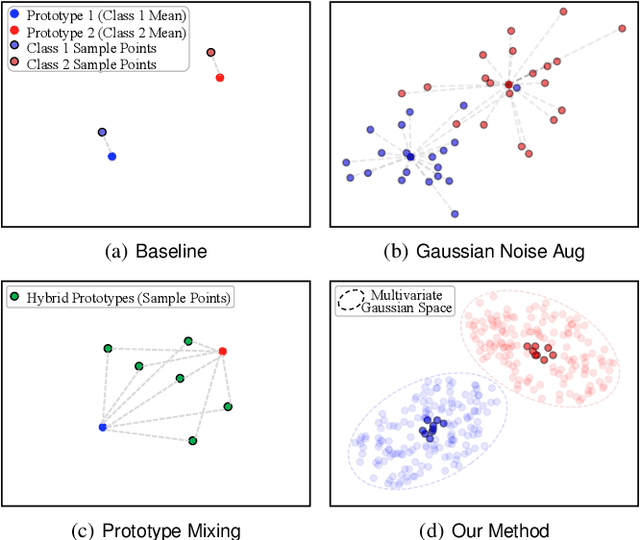
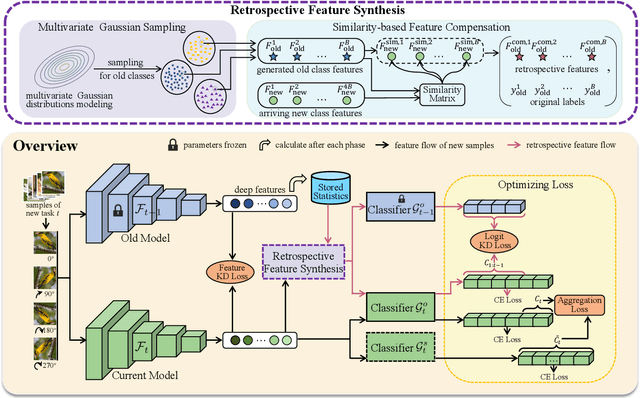
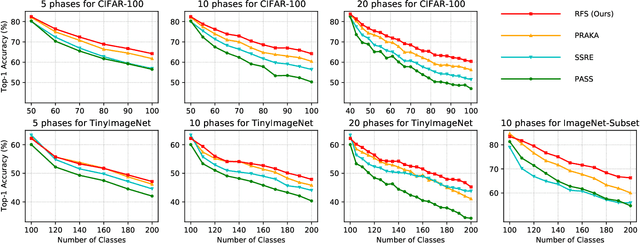
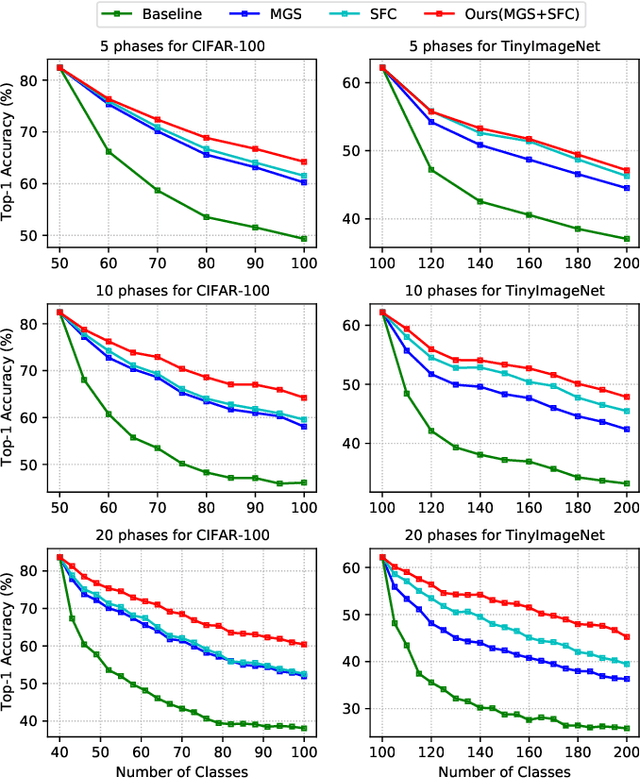
Abstract:Despite the outstanding performance in many individual tasks, deep neural networks suffer from catastrophic forgetting when learning from continuous data streams in real-world scenarios. Current Non-Exemplar Class-Incremental Learning (NECIL) methods mitigate forgetting by storing a single prototype per class, which serves to inject previous information when sequentially learning new classes. However, these stored prototypes or their augmented variants often fail to simultaneously capture spatial distribution diversity and precision needed for representing old classes. Moreover, as the model acquires new knowledge, these prototypes gradually become outdated, making them less effective. To overcome these limitations, we propose a more efficient NECIL method that replaces prototypes with synthesized retrospective features for old classes. Specifically, we model each old class's feature space using a multivariate Gaussian distribution and generate deep representations by sampling from high-likelihood regions. Additionally, we introduce a similarity-based feature compensation mechanism that integrates generated old class features with similar new class features to synthesize robust retrospective representations. These retrospective features are then incorporated into our incremental learning framework to preserve the decision boundaries of previous classes while learning new ones. Extensive experiments on CIFAR-100, TinyImageNet, and ImageNet-Subset demonstrate that our method significantly improves the efficiency of non-exemplar class-incremental learning and achieves state-of-the-art performance.
Refined Response Distillation for Class-Incremental Player Detection
May 01, 2023Abstract:Detecting players from sports broadcast videos is essential for intelligent event analysis. However, existing methods assume fixed player categories, incapably accommodating the real-world scenarios where categories continue to evolve. Directly fine-tuning these methods on newly emerging categories also exist the catastrophic forgetting due to the non-stationary distribution. Inspired by recent research on incremental object detection (IOD), we propose a Refined Response Distillation (R^2D) method to effectively mitigate catastrophic forgetting for IOD tasks of the players. Firstly, we design a progressive coarse-to-fine distillation region dividing scheme, separating high-value and low-value regions from classification and regression responses for precise and fine-grained regional knowledge distillation. Subsequently, a tailored refined distillation strategy is developed on regions with varying significance to address the performance limitations posed by pronounced feature homogeneity in the IOD tasks of the players. Furthermore, we present the NBA-IOD and Volleyball-IOD datasets as the benchmark and investigate the IOD tasks of the players systematically. Extensive experiments conducted on benchmarks demonstrate that our method achieves state-of-the-art results.The code and datasets are available at https://github.com/beiyan1911/Players-IOD.
Deep Learning for Visual Speech Analysis: A Survey
May 22, 2022
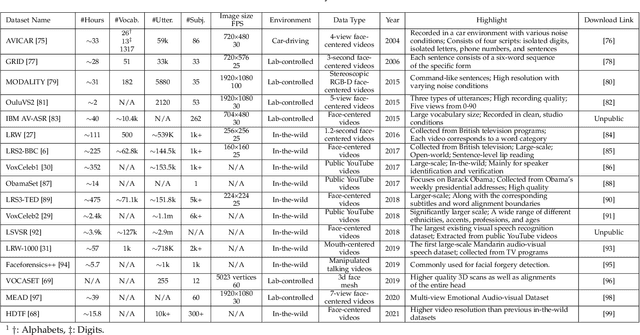
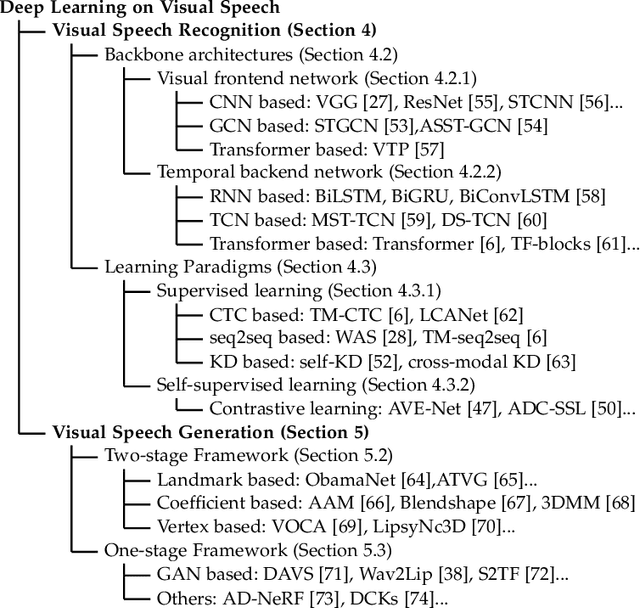

Abstract:Visual speech, referring to the visual domain of speech, has attracted increasing attention due to its wide applications, such as public security, medical treatment, military defense, and film entertainment. As a powerful AI strategy, deep learning techniques have extensively promoted the development of visual speech learning. Over the past five years, numerous deep learning based methods have been proposed to address various problems in this area, especially automatic visual speech recognition and generation. To push forward future research on visual speech, this paper aims to present a comprehensive review of recent progress in deep learning methods on visual speech analysis. We cover different aspects of visual speech, including fundamental problems, challenges, benchmark datasets, a taxonomy of existing methods, and state-of-the-art performance. Besides, we also identify gaps in current research and discuss inspiring future research directions.
 Add to Chrome
Add to Chrome Add to Firefox
Add to Firefox Add to Edge
Add to Edge